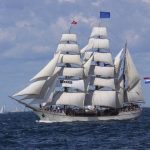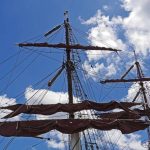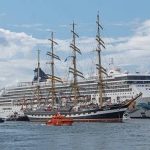As tall ship sailing becomes more popular, it is important for sailors to have reliable navigation tools to safely navigate the seas.
Navigation equipment has come a long way over the years and there are now many high-tech tools available to sailors. However, classic navigation tools still play a crucial role in tall ship sailing.
In this article, we will review some of the best navigation tools for tall ship sailing, from traditional instruments to modern apps and software.
1. Compass
The compass is a classic navigation tool used in tall ship sailing since ancient times. It is considered one of the most important navigation tools for sailors.
The earth’s magnetic field powers the compass and allows sailors to determine the direction. The compass is reliable, easy to use, and does not require electricity, which makes it a valuable tool during long voyages.
2. Sextant
The sextant is a classic navigation tool that has been used since the 18th century. It is an instrument that measures the angle between two objects, typically the horizon and a celestial body. By measuring the angles of celestial bodies such as the sun or stars, sailors can determine their position on the globe.
Although the sextant is less common in modern tall ship sailing, it is still a valuable tool to have in case of emergencies.
3. Lead line
A lead line is a rope with a weighted end that is used to measure the depth of the water. By lowering the lead line until it touches the bottom, you can read the depth markings on the rope and compare them with the charted depths.
A lead line helps you avoid running aground or hitting submerged obstacles, especially in shallow or unfamiliar waters.
4. Charts and Maps
Charts and maps are essential tools for tall ship sailing. They provide a detailed representation of the area being sailed, indicating the position of land, dangerous reefs, and shallow waters.
Navigators use charts and maps to plot their course and determine the distance and time needed to reach their destination. Paper charts and maps are still used in tall ship sailing, but electronic charts have become increasingly popular.
5. Electronic Navigation Systems
Electronic navigation systems are modern tools used in tall ship sailing. These GPS-based systems are reliable and accurate, making navigation easier and safer. They provide information on the vessel’s speed, location, direction, and course to steer.
Some of the most popular electronic systems for tall ship sailing include NOAA’s Electronic Navigational Charts, Nobeltec’s Admiral MAX Pro, and Garmin’s GPSMAP.
Navigation apps
Navigation apps are software applications that run on smart devices such as phones or tablets. They can provide various functions such as GPS, chart plotting, weather forecasting, tide and current prediction, routing, and more.
Navigation apps are convenient, portable, and affordable alternatives or supplements to other navigation tools.
Some of the best navigation apps for tall ship sailing are:
- Savvy Navvy: Savvy Navvy is a navigation app that is designed specifically for yacht sailors. It provides easily accessible wind, current, and tide overlays on detailed charts, as well as a routing algorithm that accounts for current, hazards, and sailing angles. Savvy Navvy also allows you to share your location and plans with other sailors, as well as access community tips and reviews of anchorages and marinas.
- Navionics: Navionics is a navigation app that offers high-quality charts with daily updates, as well as advanced features such as sonar charting, autorouting, dock-to-dock guidance, and community edits. Navionics also integrates with other devices and apps, such as Raymarine, Garmin, Lowrance, and Weather4D.
- iSailor: iSailor is a navigation app that uses vector charts from Transas, a leading provider of marine data. It offers accurate and reliable charts with frequent updates, as well as features such as AIS, weather overlay, track recording, and route planning. iSailor also supports external sensors and devices, such as NMEA 0183 or NMEA 2000 networks.
6. Binoculars
Binoculars are a tool that should not be overlooked in tall ship sailing. They are used to see long distances and help sailors identify objects on the horizon.
Binoculars are especially useful for spotting other vessels, identifying landmarks, and monitoring the weather. They also help sailors to navigate through fog and darkness.
7. VHF Radio
The VHF radio is a communication device that is essential in tall ship sailing. It allows sailors to communicate with other vessels, harbormasters, and rescue services. VHF radio is also used for receiving weather updates and safety alerts.
Sailors should have a VHF radio on board their vessel at all times to ensure safety at sea.
To wrap up
In conclusion, there are many navigation tools available for tall ship sailing. These range from classic tools such as the compass and sextant to modern electronic navigation systems.
Each tool has its benefits and limitations, and sailors should have a selection of tools on board to ensure safety at sea.
Proper navigation equipment is essential for tall ship sailing and can greatly enhance the sailing experience.





![The Best Tall Ship Models for Collectors [Ultimate Guide] The Best Tall Ship Models for Collectors [Ultimate Guide]](https://www.tallshipssunderland.com/wp-content/uploads/2023/03/tall-ship-models-150x150.jpg)
